|
Music Is The Healing Force Of The Universe The Inconsistency of |
|
|
||||||||||||||||
|
News from 2016 - September to December
September 1 2016
Helsinki 1966 So, this began with an email from Dirk Goedeking with the following information (from Reddit) about the Helsinki concert which Ayler played as part of the ‘Newport Jazz Festival in Europe 1966'. This was the line-up: Third Annual Helsinki Jazz Festival - 1966 First set - 7pm Second set - 10pm No date, no venue. So, onto google. The website of the Finnish Blues News site had the concert listed as happening at the Helsinki Kulttuuritalo (House of Culture) on 19th November, 1966. This seemed too late - it’s always been assumed that the infamous L.S.E. gig in London was Ayler’s last date in the tour. The Holy Ghost book gives a tentative date of 9th November, which makes more sense. Anyway, google threw up another site, which had some photographs from Helsinki, although (at the time) they were dated 1967 and had no captions. Among the photos I spotted Stan Getz, Gary Burton, Sonny Rollins, Willie ‘The Lion’ Smith, Max Roach, and one which I thought might be Albert Ayler. This was an ‘action shot’ and purposely blurred, so I emailed the photographer, Rolf Sara, and suggested he’d got the date wrong, and asked him about the ‘Ayler’ photo. He got back to me and it turned out I was wrong - it was actually Illinois Jacquet. But Rolf said he remembered Ayler from the concert and he did take a photo of him, and here it is: |
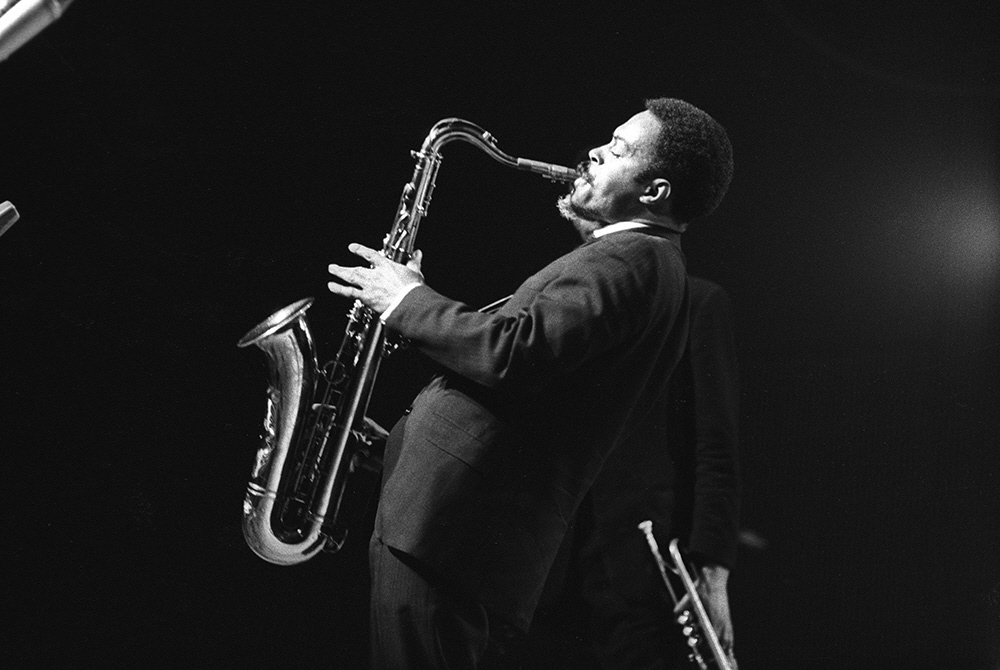 |
|
(Albert Ayler at the Third Annual Helsinki Jazz Festival - 1966 © Rolf Sara)
I asked Rolf if he remembered anything about Ayler’s performance and whether he got the same ‘mixed’ reception that had met him in Berlin, Paris and Bordeaux (we’ll never know about London because the BBC destroyed the bloody tape). Rolf replied: “There was absolutely no booing in Helsinki during or after his performance. His music was definitely avant-garde but the audience seemed to like it. ... At that time I wasn't very keen on avant-garde jazz but the audience definitely seemed to like it judging from the applause during and after his performance. I am listening to his music while I am writing this and I can understand why some people didn't like it in the sixties. To my surprise I really like his music now. I must add him to my playlists.” I also asked Rolf if he remembered seeing any TV cameras at the concert, or whether he knew if it had been recorded and he said: “The concert was filmed for TV by YLE and it was broadcast about half a year later.” And he offered to contact YLE to see if they still had the video. Unfortunately, YLE replied that the video tape had been removed from their archive due to “complicated copyright issues” and has probably been destroyed. However, they still have the audio tapes from the concert, which did take place on 9th November, 1966. According to the information supplied by YLE, the Ayler segment of the concert contained five tunes, an untitled opener (10:15), ‘Jesus’ (5:50) ‘Oaagaada’ (5:00) (?), ‘My Prayer’ (5:05) and Divine Peace Maker (4:30). In a couple of months it will be 50 years since Ayler’s 1966 European tour, and, although on the one hand it’s gratifying to know that more material has survived in various archives, on the other, it’s rather disappointing that it remains commercially unavailable. * Herbert Katz Still in Finland. As we know from the Holy Ghost box set, apart from a couple of tracks of the U.S. Army 76th A. G. Band, the earliest recordings of Albert Ayler were made in Helsinki on 30th June, 1962 with the Herbert Katz Quintet. I had a look at the YLE site and came across a short film from 1961 about jazz in Finland, Jazzia Vanhassa Talossa (Old House Jazz) which, although too early for Ayler, does feature Herbert Katz. I thought it might be of interest, and, since the Holy Ghost box is currently in limbo, here’s Ayler’s first recording of ‘Summertime’. * Sonny’s Time Now again Following on from last month’s reissue of Sonny’s Time Now, Dirk Goedeking sent me the following which possibly just adds to the confusion surrounding where that controversial album was recorded. The Croatian CD, Sunny’s Time Now & More, reckoned the LP was recorded on 24th September, 1964 at the Sid Feldman Mastertone Studio, New York - the date is obviously wrong. The recent reissue on the Skokiaan label has 17th November, 1965 in Brooklyn (which the Holy Ghost book queries, opting for ca. November 1965, Brooklyn). But here’s Amiri Baraka’s contribution. It’s taken from the sleevenotes of A Black Mass, a CD of a play by Amiri Baraka, with music by Sun Ra, issued on Son Boy Records in 1999. |
|||||||||||||||||||||||||||
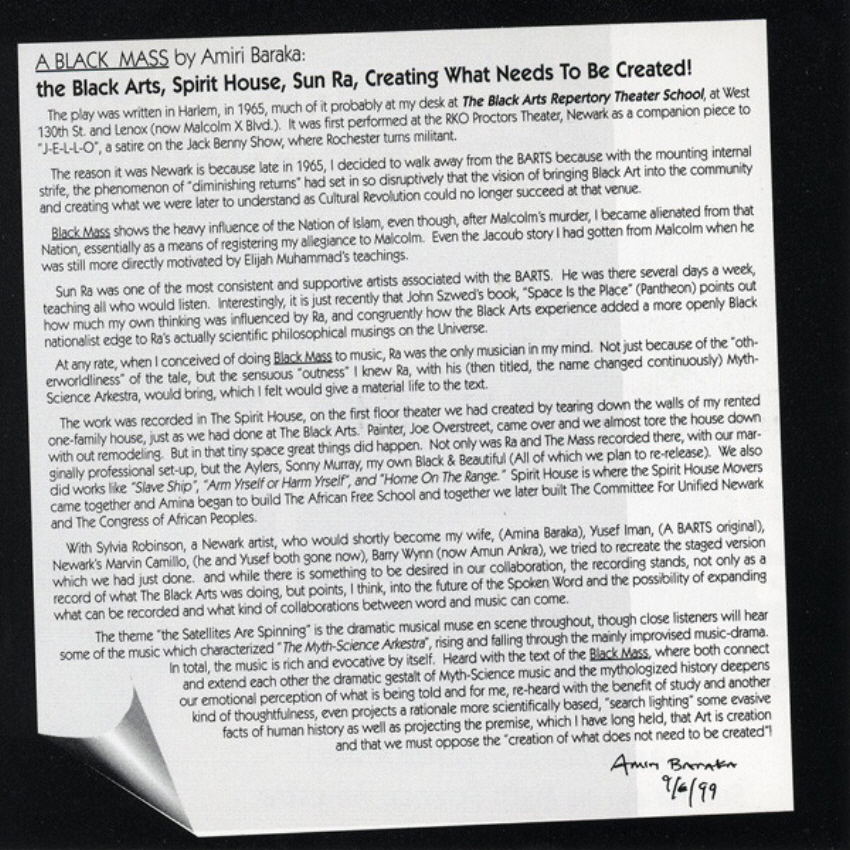 |
|||||||||||||||||||||||||||
|
So, if this is correct, then Sonny’s Time Now was recorded at Amiri Baraka’s ‘Spirit House’ at 33, Stirling Street, Newark, New Jersey. And then there’s this: |
|||||||||||||||||||||||||||
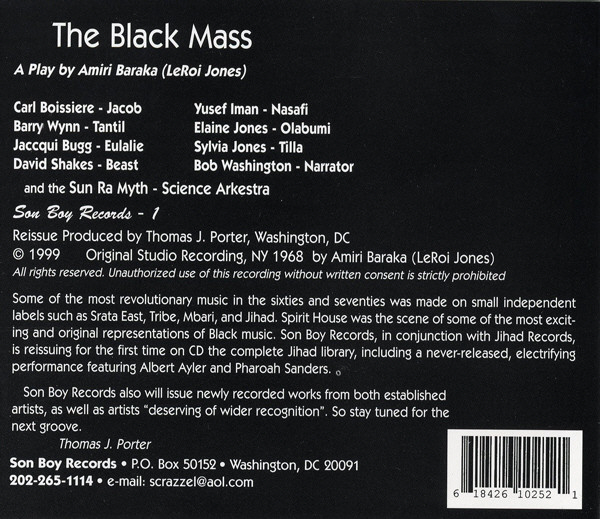 |
|||||||||||||||||||||||||||
|
So far, Son Boy Records have only reissued one more Jihad title, Black & Beautiful, Soul & Madness by Amiri Baraka & The Spirit House Movers. Amiri Baraka in September 2009, wrote the following about this release: “Black & Beautiful, Soul & Madness was the first word-music record I did completely devoted to this form. One piece on a New York Art Quartet side earlier, but Black & Beautiful was recorded at my home and in the small theater my wife, Amina, and I built there The Spirit House (33 Stirling St.) shortly after I had returned home to Newark, NJ, after the implosion of the Harlem based Blacks Arts Repertory Theater-School. Spirit House, like the Black Arts, was created to present Black theater, poetry, music and political dialogue. B&B was not the only side done on those premises, under the record label we created, Jihad A Black Mass with Sun Ra & His Myth Science Arkestra was another. Sonny's Time Now with Sonny Murray and Donald Ayler the third.” The mention of Donald Ayler is interesting. It’s a mistake, but is it just a conflation of Don Cherry and Albert Ayler, or maybe a memory of the Don Ayler session which was recorded for Jihad but never released? Even the numbering of the two available CDs is intriguing, The Black Mass is 001CD, Black & Beautiful, 003CD. And, if Sonny’s Time Now was recorded at the ‘Spirit House’ “after the implosion of the Harlem based Blacks Arts Repertory Theater-School”, when exactly was that? I found the FBI files about BART but, although they make for very interesting reading, they don’t shed much light. The only mention of Albert Ayler is a quote from a BART flier listing a couple of performances on May 21st and 22nd, 1965, so at least they can be added to the chronology. BART lost its Federal funding around September 1965 and, reading between the redactions, Baraka moved to Newark in January, 1966. So, if Sonny’s Time Now was recorded at the ‘Spirit House’, perhaps the November date is wrong. And, going back to the sleevenotes of The Black Mass, what exactly is that “never-released, electrifying performance featuring Albert Ayler and Pharoah Sanders”? Is that the one in the Holy Ghost box set? Too many questions. * Harvey Pekar, Sun Ra and Albert Ayler A while ago merzbo-derek sent me a panel from a Harvey Pekar comic relating to Albert Ayler, but it seemed a bit random, so I put it to one side. Then, last month, Dirk Goedeking sent me another one. So, I tracked down the pages they came from and here they are, just click the panels below. |
|||||||||||||||||||||||||||
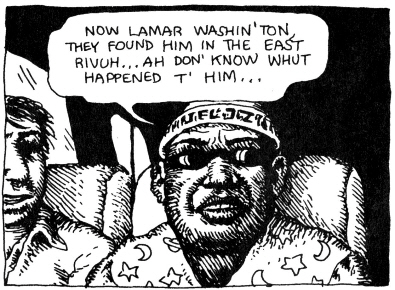 |
|||||||||||||||||||||||||||
 |
|||||||||||||||||||||||||||
|
Other Stuff 1. Before this becomes a Sun Ra site, here’s some information about Lee Morgan. Kasper Collin has finished his film about Lee Morgan, I Called Him Morgan, which will have its European premiere at the Venice Film Festival in September. Hopefully, Kasper will have more luck when it comes time to release it on DVD than he did with My Name Is Albert Ayler. 2. David Colosi hosted ‘An Appreciation of Albert Ayler’ on 1st August on Clocktower Radio in recognition of Albert’s 80th birthday. It’s still available online and worth a listen. There’s a good selection of tracks, including a couple from Swing Low Sweet Spiritual (aka Goin’ Home), which is nice, since as Ayler’s ‘straightest’ album it tends to get ignored in such programmes. 3. Steve Tintweiss let me know about this page about the Fondation Maeght LPs on Vitko’s blog, ‘Different Perspectives In My Room..!’. 4. Back in July I mentioned that Hathut’s Upcoming Releases page had an Ayler title, ‘Albert Ayler Quartet - Copenhagen Live 1964’ listed as hatOLOGY 694 - this has now been changed to hatOLOGY 665. 5. Dirk Goedeking regularly sends me details of odd compilation CDs featuring tracks by Albert Ayler, which I just add to the Compilations page and rarely mention here. However this month he sent a French one, Sous Les Pavés, Le Jazz, which caught my eye since it featured sleevenotes by Daniel Cohn-Bendit (ah well I remember those nights on the barricades of Paris...). This is the cover: |
|||||||||||||||||||||||||||
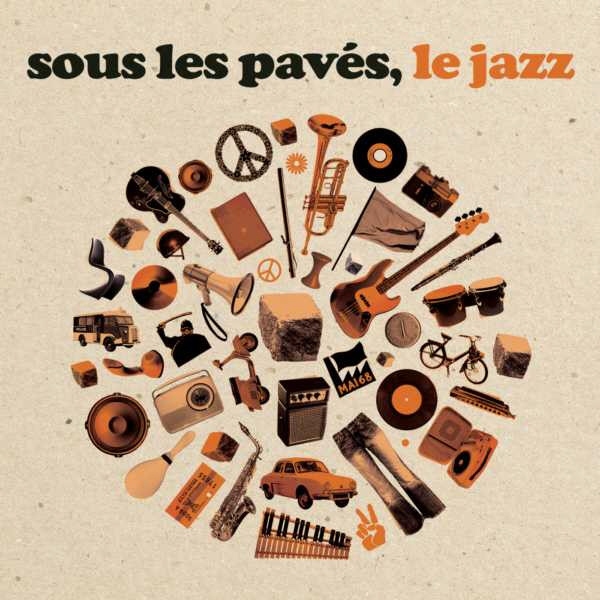 |
|||||||||||||||||||||||||||
|
The Ayler track is ‘Heart Love’ (presumably from New Grass, bad choice Danny) and, coincidentally, here’s a recent version of the same tune from Aju the Arch-Idiot & The Lewd Orchestra:
|
|||||||||||||||||||||||||||
|
What’s New July - August 2016 is now in the Archives. *** October 1 2016
Ayler on Swiss Radio Thanks to Johann Haidenbauer for letting me know about a programme on Swiss radio about Ayler which was broadcast on 13th September. Jazz Collection: Albert Ayler – legendärer und umstrittenerer Free Jazzer is available to download from the SRF site. And Johann also noticed the September issue of the Italian magazine, Musica Jazz, has a photo feature on Ayler with this Larry Fink photo of a shirtless Don and Albert in his vest. * Friends of Albert Ayler Not a new feature, more of a coincidence that three of the people whose names crop up from time to time on this site have ‘new product’ out. First, Kasper Collin, whose new film about Lee Morgan, I Called Him Morgan (which I mentioned last month) is now being shown on the festival circuit and is garnering great reviews (as his previous documentary, My Name Is Albert Ayler did). As a sample, here’s the Variety review from its showing at the Venice Film Festival, and a couple from the Toronto International Film Festival, one from Screen Daily, the other from The Film Stage. There’s also a short clip from the film on the Cineuropa site. And here, since the only photo of Kasper Collin on this site is an odd little thumbnail image, here’s a proper one of the man, taken by Henrik Andersson, from Svenska Dagbladet: |
|||||||||||||||||||||||||||
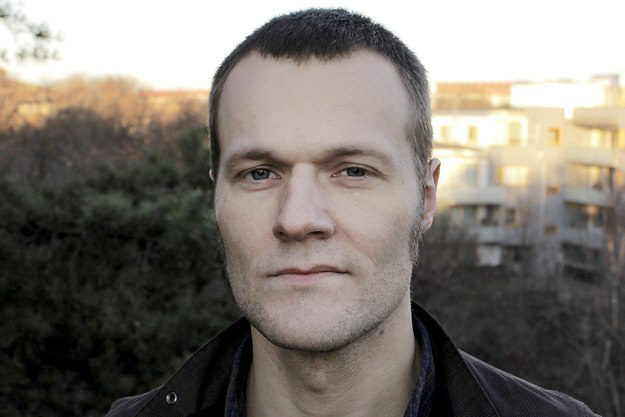 |
|||||||||||||||||||||||||||
|
Next up is Jeff Schwartz, whose online biography of Albert Ayler was invaluable to me in the early days of this site. Jeff is the bass player with the West Coast Chamber Jazz Trio and their debut album, L.A. Strictly Confidential, will be released soon on the Ictus label due to a successful Kickstarter campaign. More information about the group is available on the Kickstarter site. |
|||||||||||||||||||||||||||
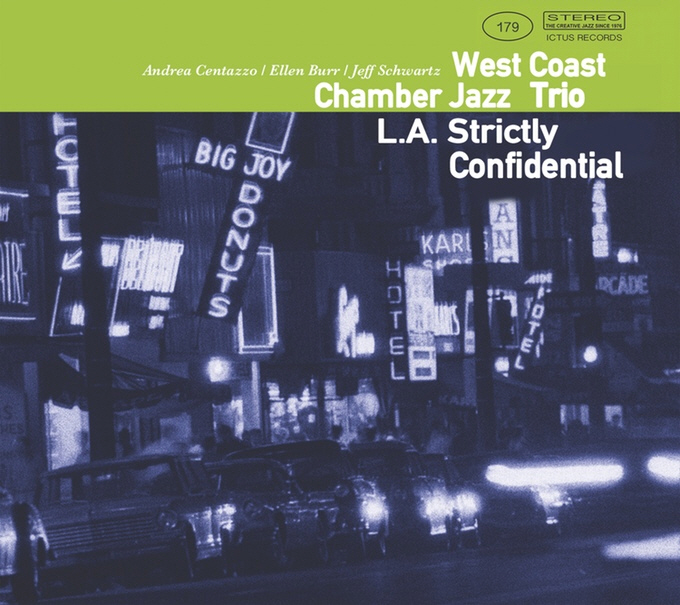 |
|||||||||||||||||||||||||||
|
And finally, there’s Steve Tintweiss, who also has a ‘new’ album out. According to Steve’s facebook page: “1st ever release of Randy Kaye led originals with all tunes recorded in one take. Randy Kaye - percussion; Enrico Rava - trumpet; Joel Peskin - tenor saxophone, bass clarinet, flute; Peter Lemer - piano; Steve Tintweiss - bass. AD transfer of master reel home recording done at WKCR-FM Columbia University by Ben Young. 2-CD set released by Philology Jazz Records in Italy. Brooklyn avant-garde jazz 1967.” The album is called Brooklyn 1967 May 24th: Tears for a Year Gone By and here’s the cover, and (courtesy of Steve) a photo of the original tape box. |
|||||||||||||||||||||||||||
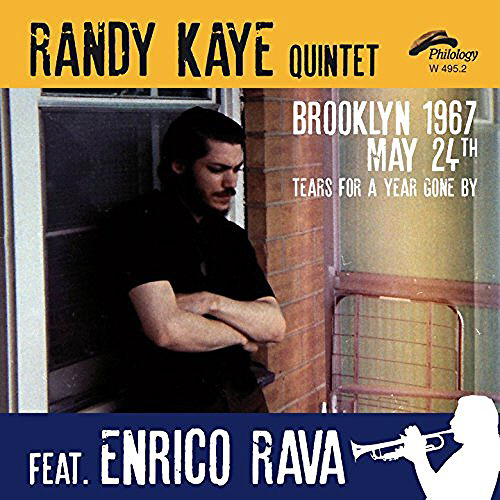 |
|||||||||||||||||||||||||||
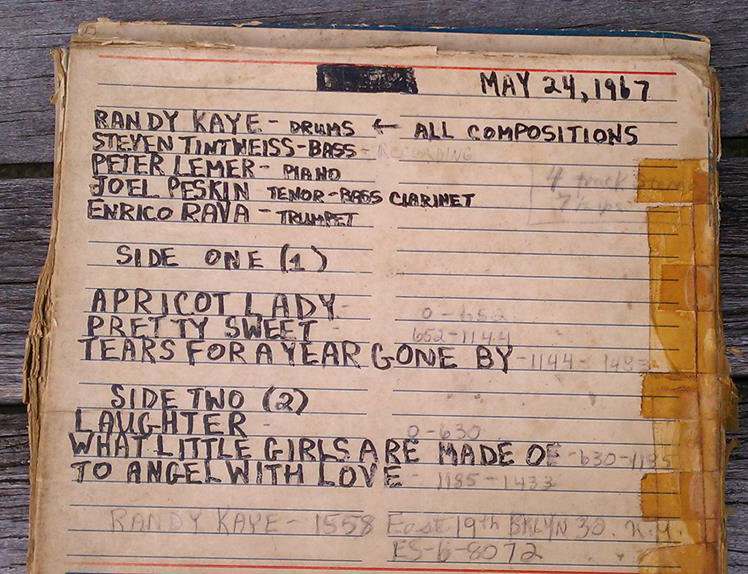 |
|||||||||||||||||||||||||||
|
Matters Discographical Right, back to Albert. Dirk Goedeking sent me some information about quadraphonic Ayler albums. Having only one working ear I’m more of a mono man myself, so I’ll hand this over to Dirk: “Something technical nobody wants to know: Albert Ayler in quadro? All of Albert’s records were recorded in mono or stereo. But ESP tried to modernize their releases by giving a technical hint how to listen in QUAD. On the back of the NYEAEC white on black edition you can see it. |
|||||||||||||||||||||||||||
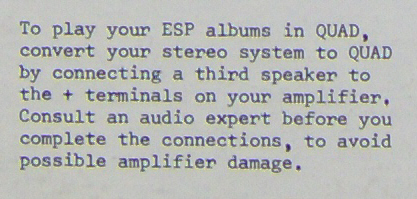 |
|||||||||||||||||||||||||||
|
Other records had it on the label: |
|||||||||||||||||||||||||||
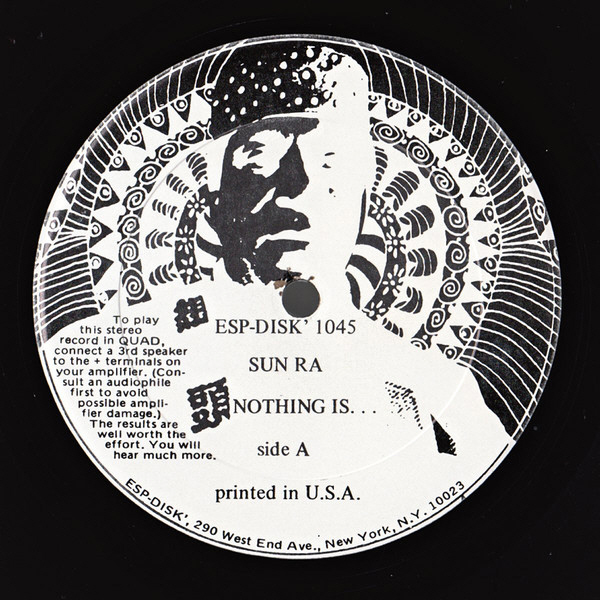 |
|||||||||||||||||||||||||||
|
Older covers simply got a red sticker. If you follow the instruction, you get a third signal. They call it "Stereo-compatible QUAD". My first receiver had an extra switch to produce this "Quadrasonic" signal for a second pair of speakers. The Drums compilation by Impulse is their only QUAD release with an Ayler track.”
I’m on safer ground with those download-only versions of My Name Is Albert Ayler with the funny names, although these are getting more sophisticated. Three more have appeared in the ‘Masters’ series: |
|||||||||||||||||||||||||||
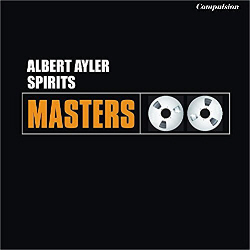 |
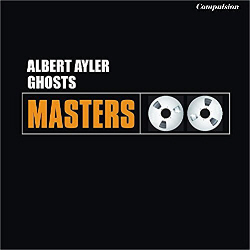 |
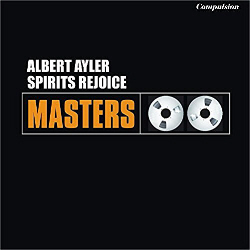 |
|||||||||||||||||||||||||
|
And then there’s these: |
|||||||||||||||||||||||||||
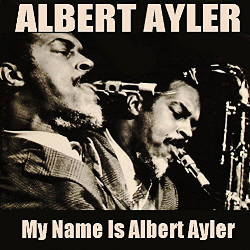 |
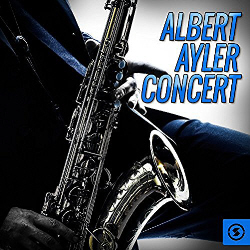 |
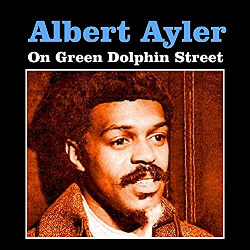 |
|||||||||||||||||||||||||
|
My Name Is Albert Ayler with that Spirits Rejoice ‘cover’ is just confusing. Disc 5 of the Holy Ghost box set has been available for some time as ‘In Concert’, but here we lose the preposition along with a couple of tracks. But the ‘best’ of the lot is probably ‘On Green Dolphin Street’ which mixes Goin’ Home with My Name Is Albert Ayler (minus Albert’s introduction). * Matters Bibliographical Dirk also sent me this: |
|||||||||||||||||||||||||||
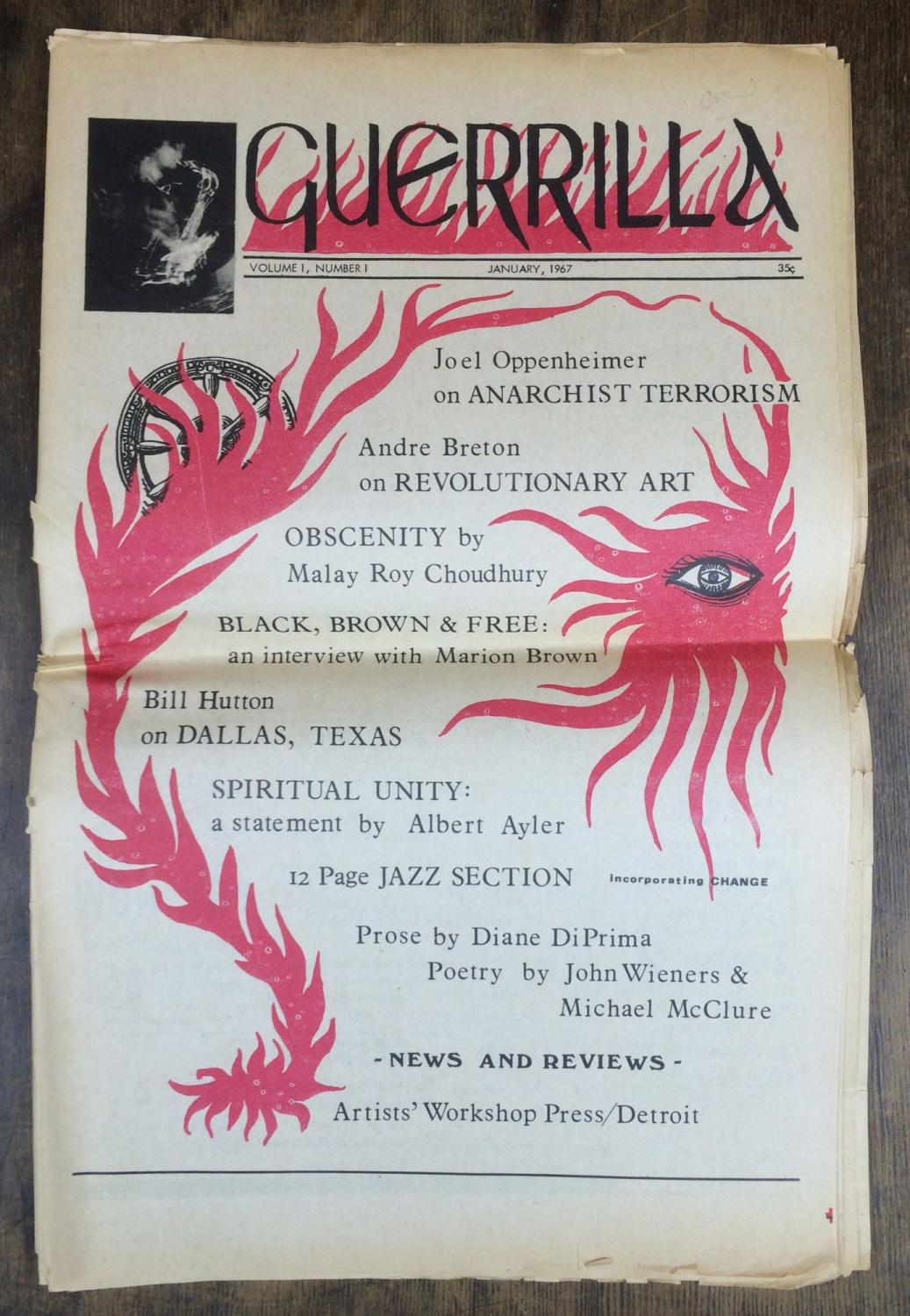 |
|
It’s a photo of the cover of the first issue of Guerilla, published in Detroit in January, 1967 by John Sinclair and Allen van Newkirk, containing ‘Spiritual Unity: a statement by Albert Ayler’. Dirk found the photo on the abebooks site, but it’s now been sold (and besides my money “wasn’t strong enough”), but I had a look round to see if there was any mention of the Ayler article elsewhere. There wasn’t, but I did find some more information about the magazine on the Detroit Artists Workshop site. The only ‘statement’ by Ayler I could think of was the weird ‘To Mr. Jones - I Had a Vision’ from The Cricket, but, checking my own site (my memory’s going) I found that other untitled piece by Ayler which was published in the International Times in March, 1967. Given the proximity of the dates, coupled with the fact that the same issue of Guerilla contained an interview with Marion Brown, as did the issue of the International Times, I think it’s safe to assume that Ayler’s untitled ‘statement’ in the International Times was a reprint of the one in Guerilla. Of course, if anyone out there could confirm this, I’d be grateful. And, a final bibliographical note to round off the month, there’s one of those fake books turning up on ebay and elsewhere. I won’t include a picture of the cover or add a link, because these things, compiled from wikipedia articles, should be treated with utter contempt. The title is Spiritual Unity: Albert Ayler by one, Eloi Rylan Koios. *** November 1 2016
Jazz Times |
|||||||||||||||||||||||||||||||||||||||||||||||
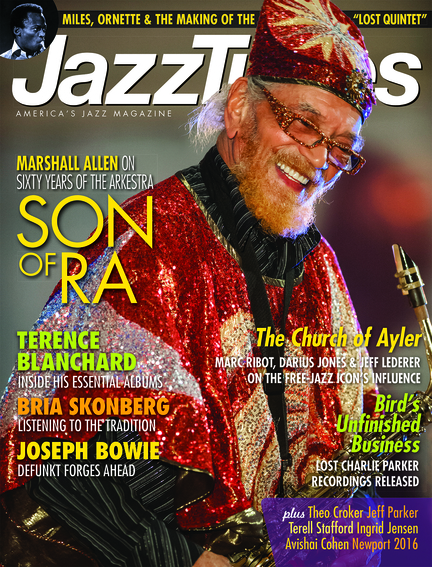 |
|||||||||||||||||||||||||||||||||||||||||||||||
|
The October issue of Jazz Times has a feature on Albert Ayler with contributions from Jeff Lederer, Marc Ribot and Darius Jones. The article, ‘Searching for Albert Ayler’ by Mac Randall, is now available online. * Interviews I came across Ayler’s Fondation Maeght interviews from the Holy Ghost box set on youtube, the ones with Daniel Caux for France Culture and Kiyoshi Koyama for Swing Journal. They’ve been on there for a couple of months, so I thought I’d just add the links on the Interviews page. * ESP Thinking about the fate of the Holy Ghost box and whether it would ever be reissued in some form or other, led me to ESP in case there was any Ayler-related news, but all I found (on the ESP facebook page) was this T-shirt. |
|||||||||||||||||||||||||||||||||||||||||||||||
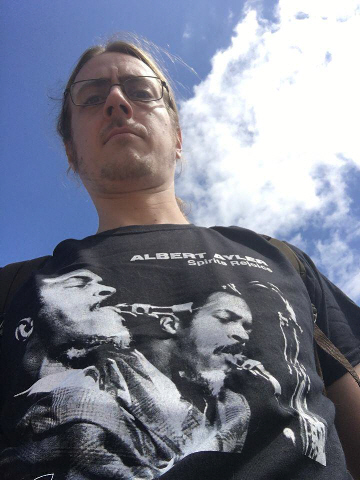 |
|||||||||||||||||||||||||||||||||||||||||||||||
|
With the accompanying blurb: “We have a new T-shirt and it is a beauty with the double photo from Albert Ayler’s LP Spirits Rejoice, made from a new scan direct from the photographer, Sandra Stollman. Here Italian Surf Academy drummer Dave Miller models it.” And on ESP’s twitter page (which also seems a bit moribund now) I found a few more items. Another composite photo similar to the Spirits Rejoice cover, presumably also by Sandra Stollman: |
|||||||||||||||||||||||||||||||||||||||||||||||
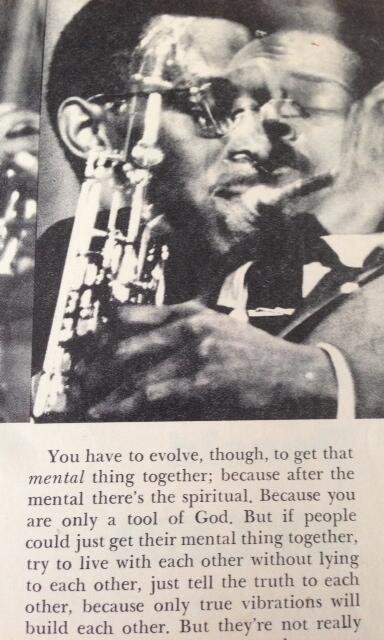 |
|||||||||||||||||||||||||||||||||||||||||||||||
|
The only information is that it’s from “an interview with Albert Ayler in 1968”. Which is more than you get with this: |
|||||||||||||||||||||||||||||||||||||||||||||||
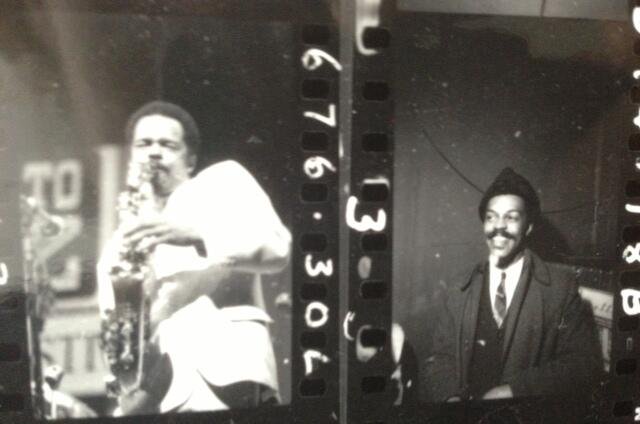 |
|||||||||||||||||||||||||||||||||||||||||||||||
|
And a final picture, this from a “1965 issue of Melody Maker”: |
|||||||||||||||||||||||||||||||||||||||||||||||
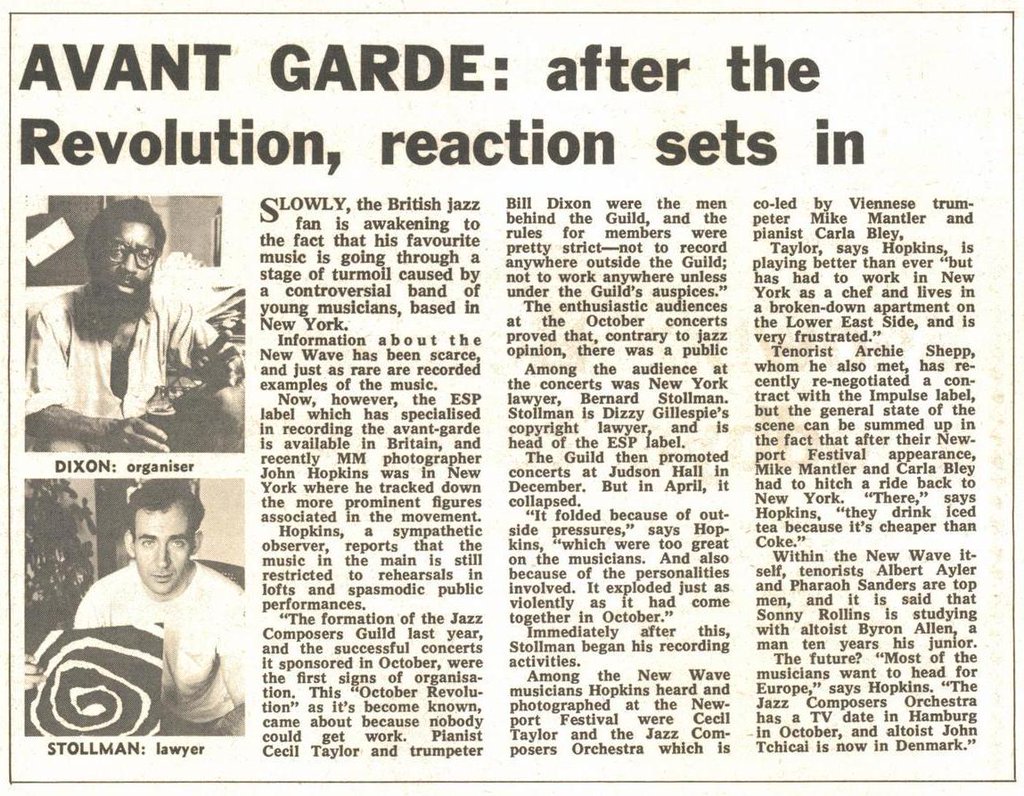 |
|||||||||||||||||||||||||||||||||||||||||||||||
|
I quite like this, since, apart from Albert being recognised as a top man, I’m so used to seeing the later photos of Bernard Stollman (“lawyer”) that when one imagines those early days of ESP, this acts as a corrective and now, for some reason, I just see Lee Harvey Oswald sitting in the recording studio listening to Spiritual Unity for the first time. * More about Quad Following last month’s item about quadraphonic versions of Ayler LPs, courtesy of Dirk Goedeking, I received an email from Richard Koloda with some additional information, which I hereby share (with no understanding whatsoever): “The quad brought back memories (I still have an SQ quad decoder) --the ESP quad was a way to use the sum and differentials of the amplifier, i.e. one backspeaker used both sets of the positive inputs, while the other backspeaker used both terminals of the amp’s negative outputs. Richard also added links to wikipedia on the Hafler circuit (“The Hafler circuit is a passive electronics circuit with the aim of getting derived surround sound or ambiophony from regular stereo recordings without using costly electronics.”) and the system used by Impulse, the QS Regular Matrix (“Quadraphonic Sound (originally called Quadphonic Synthesizer, and later referred to as RM or Regular Matrix) was a matrix 4-channel quadraphonic sound system based on the same principles as laid down by Peter Scheiber, but developed by engineer Ryosuke Ito of Sansui in the early 1970s.”). * Back to School Terrifying concept, but ’tis the season. I found myself spending a good hour rooting around the University of Virginia’s ‘History of Jazz’ course. This was prompted by Dirk Goedeking finding a breakdown of a version of ‘Ghosts’, of unidentified origin, but presumably from one of the concerts from the 1966 European Tour. This led to a list of similar treatments of other jazz classics, before I ended up on the main page, where ‘Study Space’ leads to what is essentially an advert for a book, but there’s a lot of stuff you can access, including a glossary of jazz terms - “avant-garde jazz
- and a video of Gary Giddins explaining how he got into jazz, while making the point that for most of us there’s an element of chance involved. (I’ve added it here, in case the idea of going back to school fills you with dread.) * And finally ... Here’s a clip of Ken Vandermark playing ‘Love Cry’ at PointCulture in Charleroi, Belgium on 12th October, 2016.
|
|||||||||||||||||||||||||||||||||||||||||||||||
|
December 1 2016
More on the L.S.E. Following Ronald Atkins’ article in the August edition of Jazz Journal, prompted by the 50 year anniversary of Albert Ayler’s only British concert at the London School of Economics, comes another account on the London Jazz News site. This is written by George Foster, who was present at the concert and gives a good account of the proceedings, but was also in the pub after the concert when Humphrey Lyttelton walked in: “About 20 minutes after the recording finished, Humph came in with the BBC producer Terry Henebery. I can only describe him as incandescent with rage, which seemed to be focussed on Beaver Harris for his breath-holding distraction. He and Henebery were openly vituperative about the music, the musicians’ behaviour and the recording and were quite openly saying they thought it untransmittable. It is interesting in view of the conflicting accounts of why the concert was never transmitted that scrapping it was being discussed so soon after recording. Humph says he found the whole event a sort of entertaining spectacle, but he didn’t use ‘entertaining’ among the range of adjectives that night in the pub.” And the article ends with this rather poetic thought, regarding the tape of the Ayler performance, wiped by the BBC in a cost-cutting exercise to be used again. “Ironically, producers hated to use the recycled tapes because they were very difficult to wipe fully clean. On many of them the erased recordings appeared as ‘ghosting’ - barely visible traces of figures and faces. It seems an appropriate end for music so obsessed with ghosts and spirits.” * Michel Samson - another interview Kees Hazevoet was the first to spot the L.S.E. article above, and he also sent me his translation of another interview with Michel Samson. This is the third translation Kees has provided this year. The first was an interview with Michel Samson from the Dutch magazine, Jazz Bulletin from June 2012 (‘Adventures in the New Thing’), the second, an article by Bert Vuijsje about the Hilversum session from the Dutch weekly newspaper Vrij Nederland of 5th December, 1964 (‘A recording session with Albert Ayler and Don Cherry’). The following is another Bert Vuijsje piece, an interview with Michel Samson originally published in Jazzwereld (No. 11, March 1967). The original copy is available here, and I would like to thank Bert Vuijsje for giving his permission to add this interview to the site and, as ever, thanks to Kees Hazevoet for taking the time and trouble to translate it into English.
Michel Samson: I don’t really try to play jazz By Bert Vuijsje Ornette Coleman’s concert at the Concertgebouw, October 30, 1965, had an unexpected ending. After playing alto for five numbers, Ornette took his violin and, besides David Izenzon and Charles Moffett, two other musicians joined him on stage. One of them – trumpeter Nedly Elstak – we knew, even though we didn’t expect to see him in this company. The other, a boyish violinist with the appearance of a kibbutz inhabitant, was a complete unknown to most fans in the hall. After the concert I was told that the mysterious musician’s name was Michel Samson, that he was Dutch and said to have studied with Yehudi Menuhin in Rome. A year later he was seen on the European jazz scene again, this time as a member of the Albert Ayler Quintet. During the Berliner Jazztage, I had the opportunity to talk with him for about an hour. Michel Samson was born in 1944 in Rijswijk [a small town near The Hague] and began studying the violin when he was five years old. Six years later he received a grant from the Dutch government to study in Germany. Next came studying with Yehudi Menuhin in Rome, where the composer Gian-Carlo Menotti heard him play at a festival and arranged a grant for him to study in New York with Ivan Gelamian, “the most famous pedagogue of the violin in the West”. Third stream not the real brotherhood Shortly before the concert in Amsterdam, Michel Samson met with Ornette Coleman in Paris. “I was interested in contemporary music, hence also in contemporary jazz, and I knew that Ornette Coleman was interested in the violin. Therefore we were interested in each other. He invited me to join him in Amsterdam. After that concert I went back to America; I wasn’t at all looking for a career in jazz or anything like it. In April 1966 I was in Cleveland for a concert with the Cleveland Orchestra and Albert Ayler was playing in a club at the time. I called him and went to a rehearsal and I’ve been playing with him ever since. We don’t work regularly and my concert career can continue as planned. During the upcoming winter season I have engagements in America again and I’ve also become a professor, violinist in residence they call it, at the Farleigh Dickinson University in New Jersey.” Combining classical music and avant-garde jazz is rather unusual. Doesn’t his double career cause problems with his ‘classical’ connections? “No, I can explain to them that my profession is entertainer. It is true that only very few classical musicians have any feeling for the new jazz. Only Leonard Bernstein sometimes comes to listen to Ornette or Albert. The third stream doesn’t mean much to me. A large orchestra that is just put there to let some jazz guys play with it, that is not the real brotherhood. In daily life, classical musicians don’t even speak the same language as jazz musicians. In fact, I don’t like modern western music any longer. The way Karlheinz Stockhausen occupies himself with electronic music, there is no time for that anymore. In concerts, I prefer to play standard works; Beethoven, Brahms, Bach, Mozart. I don’t really try to play jazz. I do, however, imagine how a jazz violin should sound: but I don’t feel like a pioneer... like, how am I going to integrate the violin in the negro music or something like that. My contribution to the whole is what’s important.” Peace interpreted poetically Albert Ayler often uses the word ‘peace’, but Michel Samson emphasizes that their music has nothing to do with political protest. “Peace – you should take it poetically, not politically. It shouldn’t be seen as some kind of a beatnik tag, with a badge or something. It’s bigger, goes further than that. You can look at Albert’s music as some kind of church music. The titles of his compositions are quite religious, I’d say. Our music is a religion, of course, the majesty of the arts. Albert also sees it like that. He never plays with addicts for instance, people who cannot give their energy to the music, but have to give it to some other pseudo-important thing. We prefer to play in a concert hall rather than in a club; the atmosphere is purer there anyway. In America, there are only few musicians who view their music as pure. I really only know two, Albert and Trane; the others mostly play in clubs, in Las Vegas. For instance, at the moment they are trying to promote John Handy. Even though he plays free, you still hear some commercial background. It’s like doing what’s fashionable, it isn’t beautiful, not really felt.” Inspiration not very important The reproach that the new jazz is lacking in form doesn’t affect him much. “It is a free form. Coleman employs a rhythmic form, Trane a melodic form and this [i.e. Ayler’s] is a form in the shape of freedom, to play a solo in which everybody is listening to each other. In fact, chords come down to the same thing. Chords are taken too literally by bebop people. If you would interpret chords poetically... Take Mozart for instance, in classical music there also are forms, but the greatest composers always reigned majestically in interpreting those forms as freely as possible. If you would take our form literally, it would become a very complicated form. All these compositions would become more or less the same and it is possible to catch it in exact terms. In that sense it is connected with the classical form of chords in a chorus. Planned chaos? That sounds very distant from peace to me. Chaos as peaceful as the one created by us can only exist when there is real peace, that you take a solo and people silently stand by listening. It happens intuitively because it’s a unit. It’s about listening rather than thinking of chords. We listen to each other rather than thinking of where to put our hands. It is like a conversation, sometimes there are days that you don’t talk much. If I don’t feel like it, I just don’t solo. It’s not about inspiration, but about entirely different things. If for instance your hands are cold, your inspiration may perhaps suffer from the material battle, but generally speaking I don’t consider inspiration to be very important. One of the things that strikes me about Albert is that he never struggles with technique. Albert has a fabulous technique, nobody but he can make such long strophes on a saxophone .” Everybody in New York plays free The fact that today many musicians are involved in avant-garde jazz isn’t considered to be positive by Michel Samson. “With everybody making records for ESP, people like Ornette and Trane and Albert have become less unusual, while in fact they are still equally exceptional. All those people who have recorded for ESP aren’t as great as Ornette. You know, everybody in New York is now playing free. It’s fashionable like LSD. In Europe there only are copycats. When Piet Kuiters imitates Cecil Taylor everybody likes it, but in America that’s impossible! Piet Kuiters came to New York with Tchicai; nobody came to listen, only the Danish consulate. When I’m in New York, I only listen to Ornette and Trane and to Pharoah Sanders and Don Cherry”. Originally published in Jazzwereld No. 11, March 1967. Translated by Cornelis J. Hazevoet, Ph.D Lisbon, August 2016. * Don Cherry Don Cherry would have been 80 on 18th November and here's a link to an interview he gave to Ben Sidran on NPR. This has been on youtube for a few years now, so maybe everybody's already heard it, but for those who haven't, there's a great bit about having to take a job washing dishes at Los Angeles airport after he'd left Ornette Coleman and was waiting to join Sonny Rollins, and (around the 37 minute mark) he recounts the tale of the first time he heard Albert Ayler. * ESP I was getting a bit worried about the lack of activity on the ESP website this year, so was pleasantly surprised when I checked it for this update and found it’s undergone a complete refit. * And finally ... Dirk Goedeking sent me some suggestions for Christmas presents for the Ayler fan who has everything. |
|||||||||||||||||||||||||||||||||||||||||||||||
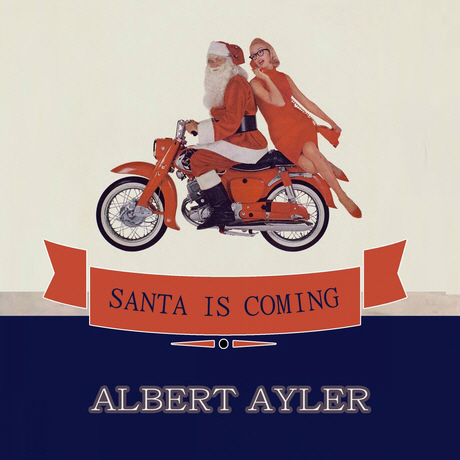 |
|||||||||||||||||||||||||||||||||||||||||||||||
|
At last! Albert Ayler’s lost Christmas album - or, another download-only version of My Name Is Albert Ayler, this one mixed with Something Different!!!!! How about an Albert Ayler Shower Curtain? |
|||||||||||||||||||||||||||||||||||||||||||||||
 |
|||||||||||||||||||||||||||||||||||||||||||||||
|
With matching bath towel? |
|||||||||||||||||||||||||||||||||||||||||||||||
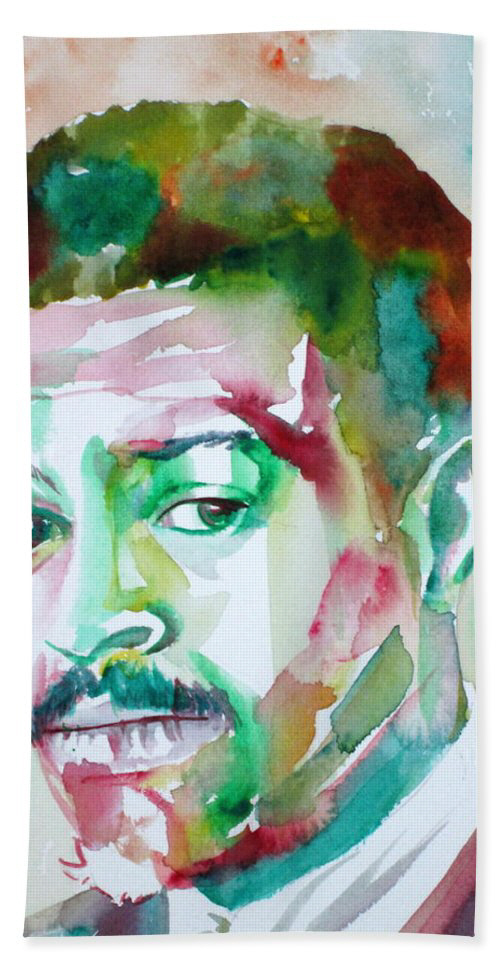 |
|||||||||||||||||||||||||||||||||||||||||||||||
|
Or a cushion? |
|||||||||||||||||||||||||||||||||||||||||||||||
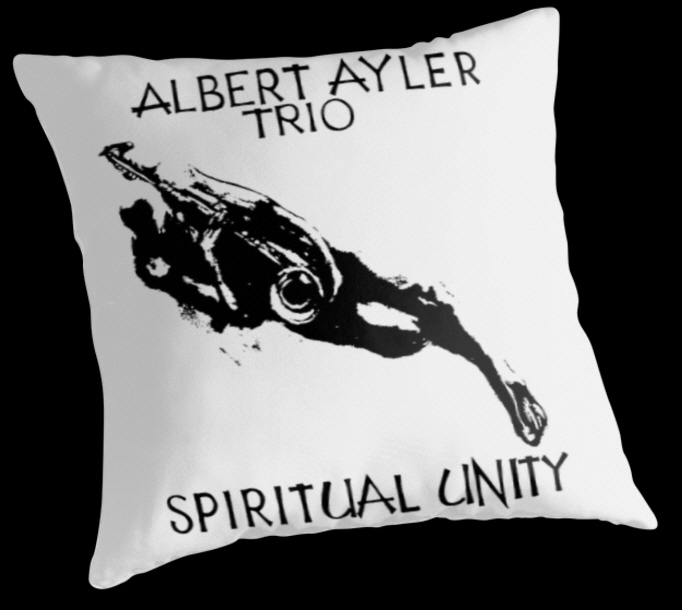 |
|||||||||||||||||||||||||||||||||||||||||||||||
|
A bag? |
|||||||||||||||||||||||||||||||||||||||||||||||
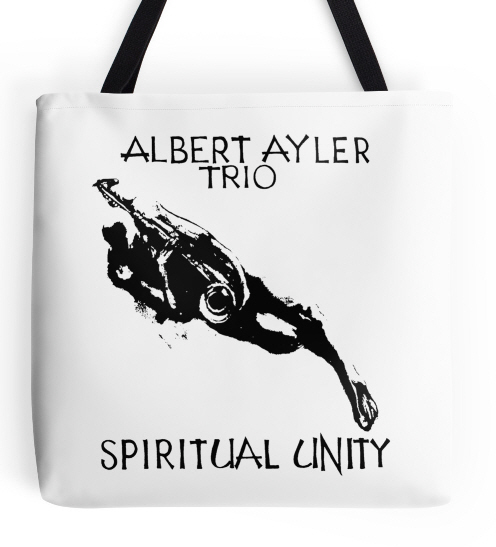 |
|||||||||||||||||||||||||||||||||||||||||||||||
|
A coaster? |
|||||||||||||||||||||||||||||||||||||||||||||||
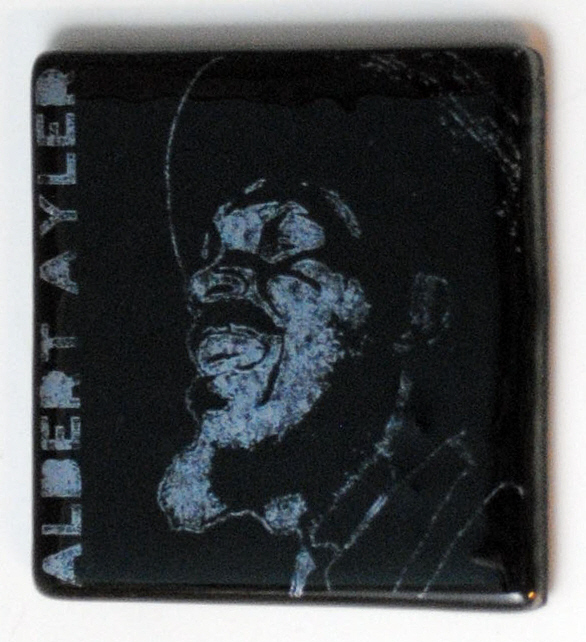 |
|||||||||||||||||||||||||||||||||||||||||||||||
|
|
|||||||||||||||||||||||||||||||||||||||||||||||
|
A clock? |
|||||||||||||||||||||||||||||||||||||||||||||||
 |
|||||||||||||||||||||||||||||||||||||||||||||||
|
T-shirts? |
|||||||||||||||||||||||||||||||||||||||||||||||
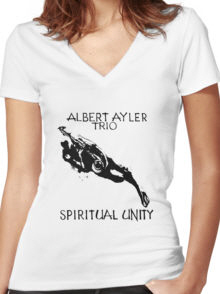 |
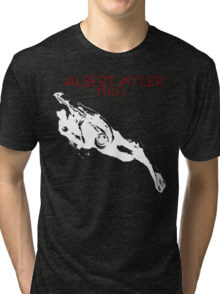 |
||||||||||||||||||||||||||||||||||||||||||||||
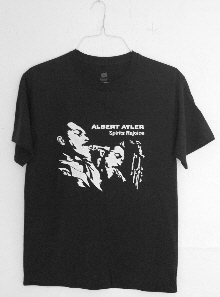 |
|||||||||||||||||||||||||||||||||||||||||||||||
|
Phone covers? |
|||||||||||||||||||||||||||||||||||||||||||||||
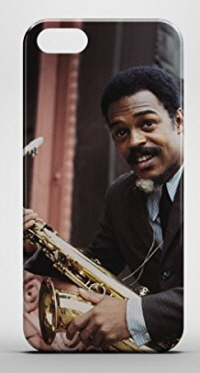 |
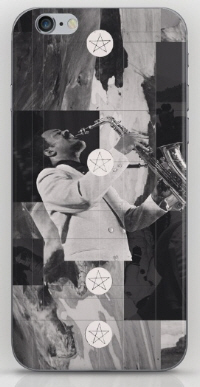 |
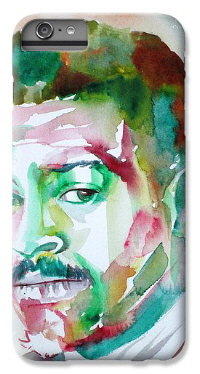 |
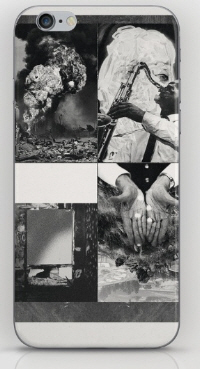 |
||||||||||||||||||||||||||||||||||||||||||||
|
I must admit, though, I do rather like this lapel pin: |
|||||||||||||||||||||||||||||||||||||||||||||||
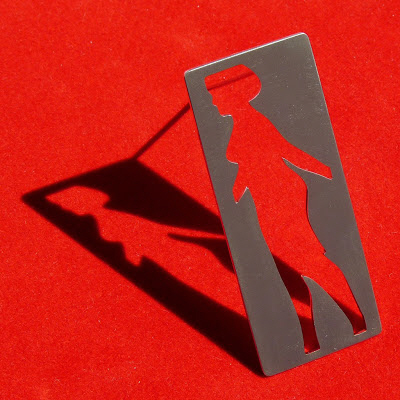 |
|||||||||||||||||||||||||||||||||||||||||||||||
|
And there seems to be a definite gap in the market for some budding entrepreneur - where are the Albert Ayler socks? Anyway, have a good Christmas, and, Trump willing, I’ll be back in the New Year. |
|||||||||||||||||||||||||||||||||||||||||||||||
|
*** News from 2004 (January - June) 2004 (July - December) 2005 (January - May) 2005 (June - December) 2010 (January - June) 2010 (July - December) 2011 (January - May) 2011 (June - September) 2011 (October - December) 2012 (January - May) 2012 (June - December) 2013 (January - June) 2013 (July - September) 2013 (October - December) 2014 (January - June) 2014 (July - December) 2015 (January - May) 2015 (June - August) 2015 (September - December) 2016 (January - March) 2016 (April - June) 2016 (July - August) 2017 (January - May) 2017 (June - September) 2017 (October - December) 2018 (January - May) 2018 (June - September) 2018 (October - December) 2019 (January - May) 2019 (June - September) 2019 (October - December) 2020 (January - April) 2020 (May - August) 2020 (September - December) 2021 (January - March) 2021 (April - July) 2021 (August - December) 2022 (January - April) 2022 (May - August) 2022 (September - December) 2023 (January - March) 2023 (April - June) 2023 (July - September) 2023 (October - December) 2024 (January - March) 2024 (April - June) 2024 (July - September) 2024 (October - December) 2025 (January - March)
|
|||||||||||||||||||||||||||||||||||||||||||||||
|
Home Biography Discography The Music Archives Links What’s New Site Search
|
|||||||||||||||||||||||||||||||||||||||||||||||
